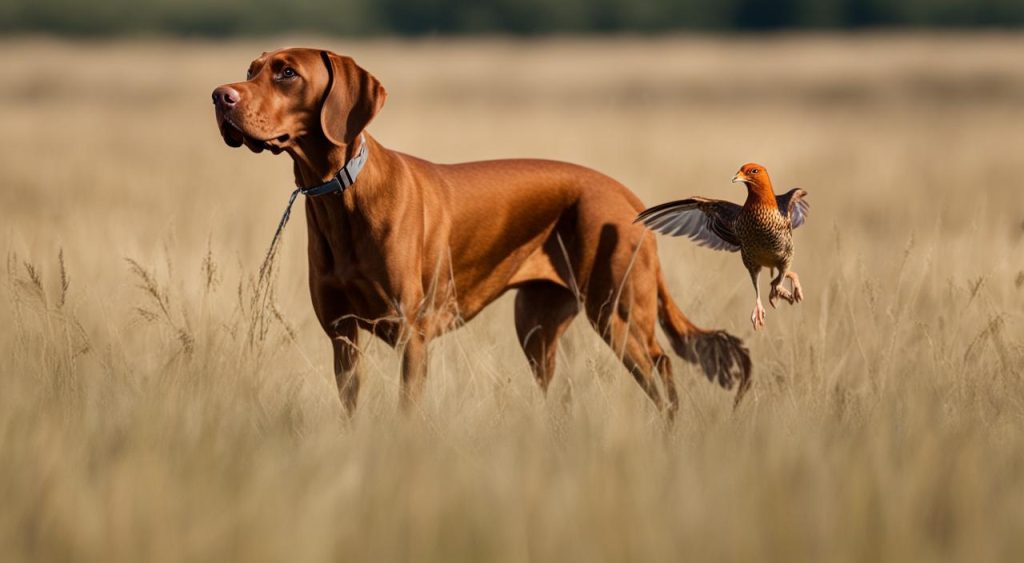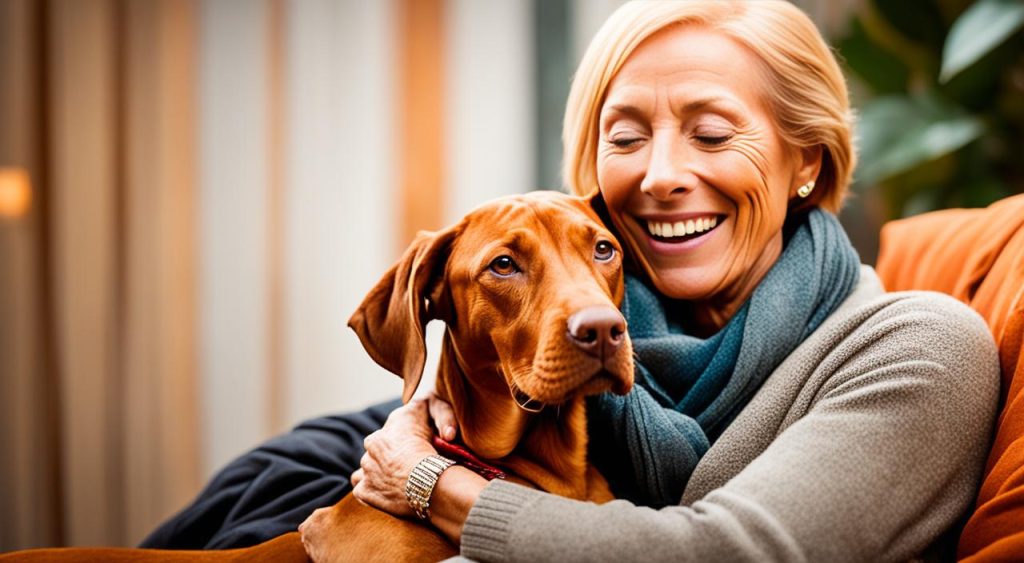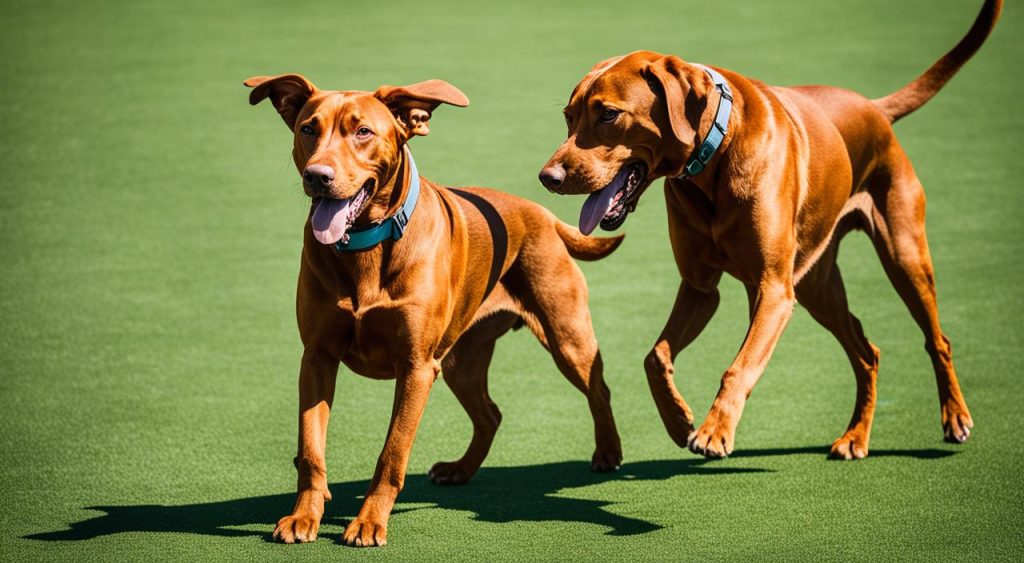If you’re curious about the Vizsla breed and its hunting abilities, you may be wondering if it leans more towards being a pointer or a retriever. In fact, the Vizsla is a versatile hunting dog that combines traits from both pointers and retrievers. This unique combination makes them highly skilled in the field and sought after by hunters all over the world.
The Vizsla breed originated in Hungary and has a long history as a hunting companion for the Magyar tribes. Their excellent hunting instincts and abilities have been refined over centuries of selective breeding. Today, they are known for their exceptional speed, agility, and tracking skills.
In terms of characteristics, Vizslas have a natural instinct for pointing, which is a behavior where they raise one leg and point their tail and nose towards the prey. This pointer behavior is a distinct trait of the breed. Additionally, Vizslas are proficient retrievers, capable of retrieving game on both land and in water. They have excellent noses and tracking abilities that make them highly effective in locating and bringing back prey.
As family pets, Vizslas are gentle, loyal, and affectionate. They form strong bonds with their families and thrive on interaction and attention. However, it’s important to note that Vizslas are high-energy dogs that require regular exercise and mental stimulation to keep them happy and healthy. They are happiest when they have access to a large, fenced yard where they can run and play.
Key Takeaways:
- The Vizsla is a versatile hunting dog that combines traits of both pointers and retrievers.
- They have a natural instinct for pointing and are proficient retrievers.
- Vizslas originated in Hungary and have a long history as hunting companions.
- As family pets, they are gentle, loyal, and affectionate.
- Vizslas require regular exercise and mental stimulation to thrive.
The Characteristics of Vizslas
Vizslas possess a range of characteristics that make them excellent hunting dogs. They have a natural instinct for pointing, which is a behavior that involves raising one leg and pointing their tail and nose in the direction of their prey. This pointer behavior is a distinctive trait of the Vizsla breed. Additionally, Vizslas are proficient retrievers, able to retrieve game both on land and in water. They have excellent noses and tracking abilities, making them skilled at locating and retrieving prey. Their small size and agility allow them to navigate tight spaces and chase prey for extended periods of time. Vizslas are also known for their quiet and patient hunting style, only barking when necessary. Overall, their combination of pointer and retriever traits makes them highly effective in the field.
The History of Vizslas
The Vizsla breed has a long and rich history that can be traced back to the 10th century in Hungary. These dogs were originally used by the Magyar hunters, who relied on Vizslas to assist them in hunting while riding on horseback.
What sets the Vizslas apart from other hunting dog breeds of that time is that they were also kept as companion dogs by the Hungarian aristocracy. This dual role of hunting and companionship was a testament to their exceptional skills and temperament.
“Their hunting abilities and versatile skills in pointing, flushing, and retrieving made them highly valued hunting companions.”
Throughout the years, the breed’s hunting instincts and abilities were carefully preserved through selective breeding. This has resulted in Vizslas becoming the perfect gun dogs for various types of hunting.
Vizslas as Family Dogs
In addition to their role as hunting dogs, Vizslas are also known for their suitability as family pets. They are gentle, loyal, and extremely affectionate, making them excellent companions.
“Vizslas have a loving and eager-to-please temperament, which makes them a great choice for families,” says Sarah Johnson, a Vizsla owner and trainer. “They are known for their devotion to their owners and their desire to be part of the family.”
However, it’s important to note that Vizslas are high-energy dogs that require regular exercise and mental stimulation. “Vizslas are active dogs that enjoy outdoor activities, such as running, hiking, and playing fetch,” advises Johnson. “They need at least an hour of exercise every day to stay happy and healthy.”
Vizslas thrive on interaction and attention from their owners and form strong bonds with their families. “They are very people-oriented and love being involved in family activities,” says Johnson. “Whether it’s going on a family outing or just cuddling on the couch, Vizslas are happiest when they’re with their loved ones.”
Vizslas are known for their love of running and their need for a large fenced yard to fulfill their exercise requirements. “A secure yard is essential for a Vizsla,” notes Johnson. “They have a strong prey drive and can easily become distracted if they’re not in a safe and enclosed environment.”
It’s important to provide proper training and socialization for Vizslas to ensure they become well-adjusted family members. “Vizslas are intelligent and eager to please, but they can be stubborn at times,” explains Johnson. “Consistent and positive training methods work best with this breed.”
Adequate socialization is crucial for Vizslas, especially with other animals and children. “Early socialization helps Vizslas become well-behaved and friendly around other pets and people,” says Johnson. “It’s important to expose them to different situations and environments from a young age to prevent any potential behavioral problems.”
In summary, Vizslas make wonderful family dogs due to their gentle temperament, loyalty, and affectionate nature. However, it’s crucial to provide them with regular exercise, mental stimulation, and proper training to ensure they thrive in a family setting.
Training a Vizsla as a Hunting Companion
If you intend to train your Vizsla as a hunting companion, it’s important to start the training at a young age. Socialization should begin early to expose them to different sights, sounds, and people. Vizslas are known for their intelligence and trainability, but they can be easily distracted during training.
Consistency and positive reinforcement are key when training a Vizsla, as they respond best to kind and gentle methods. Basic training should be combined with exposure to hunting situations to develop their hunting instincts and skills.
“Proper training and socialization are crucial to ensure a well-behaved and well-adjusted Vizsla in a hunting role.”
Professional trainers with experience in training hunting dogs can provide valuable guidance in training a Vizsla for hunting. They can help you establish a training plan tailored to the unique needs of your Vizsla and offer expert advice on techniques and exercises.
Remember, the key to successful Vizsla hunting training is patience, consistency, and positive reinforcement. By nurturing their natural abilities and providing them with the necessary training and exposure, you can transform your Vizsla into a skilled and reliable hunting companion.
Conclusion
In conclusion, the Vizsla breed is a remarkable combination of pointer and retriever traits, making them exceptional hunting dogs. Their ability to point, flush, and retrieve game is unmatched, thanks to their speed, agility, and tracking abilities. Vizslas excel in various hunting environments and are highly effective in the field.
Aside from their hunting prowess, Vizslas also make wonderful family pets. Their gentle temperament, loyalty, and affectionate nature make them great companions. However, it’s important to note that Vizslas require a significant amount of exercise, training, and attention to thrive.
Whether you’re looking for a skilled gun dog or a loving family member, the Vizsla breed offers both. Their hunting abilities and versatility, combined with their gentle and loyal nature, make them a breed that brings joy and companionship to their owners.





